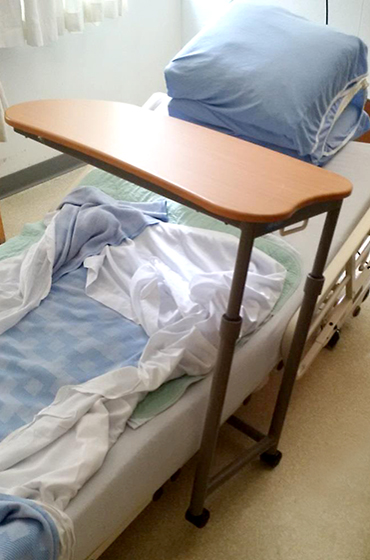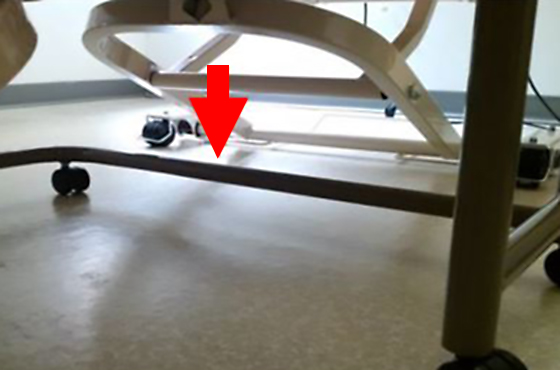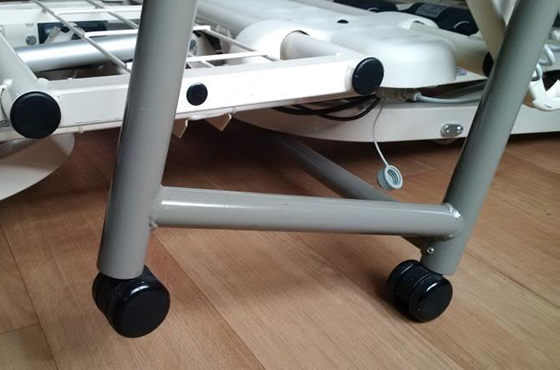ECRI Institute's complete weekly summary of medical device hazard and recall information is available in ECRI Institute's
Health Devices Alerts
(HDA). For more information about
HDA or other ECRI Institute services, visit
www.ecri.org or contact us at
clientservices@ecri.org.
UMDNS Device Terms
Beds, Electric [10347]
Tables, Overbed [13963]
Geographic Regions
Worldwide
Problem
1. Patients may become trapped between an electric low-profile bed and an overbed table, resulting in patient harm.
2. If a bed is lowered while an overbed table base is under the bed, the bed base frame and the base of the overbed table may interact, causing the overbed table to tip over (Figure 1). Items on the table may be thrown off or spilled.
3. In the worst-case scenario, a patient may become trapped between the bed and the overbed table, resulting in patient harm or even death.
|
 Figure 1. Overbed table tipping because of interaction with low-profile bed frame.
Figure 1. Overbed table tipping because of interaction with low-profile bed frame. |
ECRI Institute Recommendations
Clinicians
1. Do not lower an electric low-profile bed when an overbed table base or other equipment is underneath the bed.
2. Do not allow patient access to the bed height control.
3. Clinicians should be responsible for any height adjustment. Keep height adjustment functions locked when not in use.
Clinical Engineering/Facilities Management/Bed Technicians
1. During acceptance inspection or deployment of beds, ensure that there is adequate clearance between the bottom of the bed and floor at the lowest possible position with the overbed table used in that care unit.
2. Do not use overbed tables with low-profile beds if the interaction results in tipping of the overbed table when the bed is at the lowest bed position.
3. If the overbed table is not suitable for use with a low-profile bed, either:
a) Ensure that patient control of bed height is disabled and height is changed only by a clinician, and/or
b) Remove the overbed table from use, and replace it with an alternative table solution
4. Report any incidents of bed-related entrapment as per your facility policy.
Background
1. ECRI Institute has received multiple reports from a member hospital about an overbed table tipping when a low-profile bed height was adjusted.
a) One of the reported incidents resulted in entrapment between the bed and the overbed table, potentially contributing to patient death.
b) The member facility was able to replicate the incident. When the overbed table is positioned under the bed with the table surface over the bed, the frame of the low-profile bed can interact (collide) with the overbed table base when the bed is lowered and result in tipping of the overbed table (Figures 2 and 3).
2. FDA has published guidance about entrapment with beds. This guidance, however, does not address entrapment as a result of accessory equipment used with the bed (e.g., overbed tables). According to an FDA report, "between January 1, 1985, and January 1, 2013, FDA received 901 incidents of patients caught, trapped, entangled, or strangled in hospital beds."
3. Overbed tables with C-shaped bases may be particularly susceptible to this problem because of the tendency to apply pressure to the base frame in a manner that results in tipping the table.
 Figure 2. Low-profile bed frame and overbed table base.
Figure 2. Low-profile bed frame and overbed table base. |
 Figure 3. Overbed table tipping because of interaction with the low-profile bed frame.
Figure 3. Overbed table tipping because of interaction with the low-profile bed frame. |
Resources
United States. Food and Drug Administration. Hospital bed system dimensional and assessment guidance to reduce entrapment [guidance document online]. 2015 Jun 19 [cited 2018 Jan 12]. Available from:
https://www.fda.gov/MedicalDevices/DeviceRegulationandGuidance/GuidanceDocuments/ucm072662.htm.

